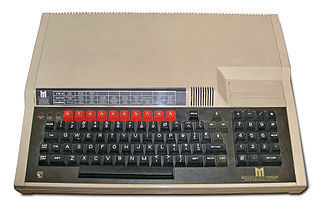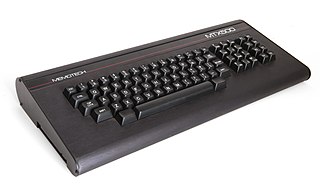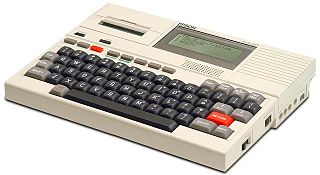
Apple II is a series of microcomputers manufactured by Apple Computer, Inc. from 1977 to 1993. The first Apple II model, that gave the series its name, was designed by Steve Wozniak, and was first sold on June 10, 1977. Its success led to it being followed by the Apple II Plus, Apple IIe, Apple IIc, and Apple IIc Plus, with the 1983 IIe being the most popular. The name is trademarked with square brackets as Apple ][, then, beginning with the IIe, as Apple //.

The Amstrad CPC is a series of 8-bit home computers produced by Amstrad between 1984 and 1990. It was designed to compete in the mid-1980s home computer market dominated by the Commodore 64 and the ZX Spectrum; it successfully established itself primarily in the United Kingdom, France, Spain, and the German-speaking parts of Europe, and also Canada.

The Commodore PET is a line of personal computers produced starting in 1977 by Commodore International. A single all-in-one case combines a MOS Technology 6502 microprocessor, Commodore BASIC in read-only memory, keyboard, monochrome monitor, and, in early models, a cassette deck.

The KIM-1, short for Keyboard Input Monitor, is a small 6502-based single-board computer developed and produced by MOS Technology, Inc. and launched in 1976. It was very successful in that period, due to its low price and easy-access expandability.

The Acorn Atom is a home computer made by Acorn Computers Ltd from 1980 to 1982, when it was replaced by the BBC Micro. The BBC Micro began life as an upgrade to the Atom, originally known as the Proton.

MicroBee was a series of networkable home computers by Applied Technology, which became publicly listed company MicroBee Systems Limited soon after its release. The original Microbee computer was designed in Australia by a team including Owen Hill and Matthew Starr.

The Compukit UK101 microcomputer (1979) is a kit clone of the Ohio Scientific Superboard II single-board computer, with a few enhancements for the UK market - notably replacing the 24×24 screen display with a more useful 48×16 layout working at UK video frequencies. The video output is black and white with 256 semigraphic characters generated by a two kilobyte ROM. It has no bit-mapped graphics capability. The video is output through a UHF modulator, designed to connect to a TV set.

The BBC Master is a home computer released by Acorn Computers in early 1986. It was designed and built for the British Broadcasting Corporation (BBC) and was the successor to the BBC Micro Model B. The Master 128 remained in production until 1993.
The Acorn Communicator is a discontinued business computer developed by Acorn Computers. Mentioned in the computing press in late 1984 as the C30, previewed in early 1985 with estimated pricing between £500 and £800, in late 1985 with a built-in LCD display, and subsequently unveiled in a slightly different form, the system sold in very low numbers to companies requiring a computer with a built-in modem.

The Rainbow 100 is a microcomputer introduced by Digital Equipment Corporation (DEC) in 1982. This desktop unit had a monitor similar to the VT220 and a dual-CPU box with both 4 MHz Zilog Z80 and 4.81 MHz Intel 8088 CPUs. The Rainbow 100 was a triple-use machine: VT100 mode, 8-bit CP/M mode, and CP/M-86 or MS-DOS mode using the 8088. It ultimately failed to succeed in the marketplace which became dominated by the simpler IBM PC and its clones which established the industry standard as compatibility with CP/M became less important than IBM PC compatibility. Writer David Ahl called it a disastrous foray into the personal computer market. The Rainbow was launched along with the similarly packaged DEC Professional and DECmate II which were also not successful. The failure of DEC to gain a significant foothold in the high-volume PC market would be the beginning of the end of the computer hardware industry in New England, as nearly all computer companies located there were focused on minicomputers for large organizations, from DEC to Data General, Wang, Prime, Computervision, Honeywell, and Symbolics Inc.

The Tangerine Microtan 65 was a 6502-based single board microcomputer, first sold in 1979, that could be expanded into what was, for its day, a comprehensive and powerful system. The design became the basis for what later became the Oric Atmos and later computers. Those later machines have similar keyboard addressing and tape I/O as the Microtan 65. The Microtan 65 has a hardware single step function that can be used for debugging software in both ROM and RAM. The computer was available as ready-built boards or as kits consisting of board and components requiring soldering together.

The Memotech MTX500 and MTX512 are a range of 8-bit Zilog Z80A based home computers released by the British company Memotech in 1983 and sold mainly in the UK, France, Germany and Scandinavia. Originally a manufacturer of memory add-ons for Sinclair machines, Memotech developed their own competing computer when it was perceived the expansion pack business would no longer be viable.

The HX-20 is an early laptop released by Seiko Epson in July 1982. It was the first notebook-sized portable computer, occupying roughly the footprint of an A4 notebook while being lightweight enough to hold comfortably with one hand at 1.6 kilograms (3.5 lb) and small enough to fit inside an average briefcase.

The AT&T UNIX PC is a Unix desktop computer originally developed by Convergent Technologies, and marketed by AT&T Information Systems in the mid- to late-1980s. The system was codenamed "Safari 4" and is also known as the PC 7300. An updated version with larger hard drive was dubbed the "3B1". Despite the latter name, the system had little in common with AT&T's line of 3B series computers. The system was tailored for use as a productivity tool in office environments and as an electronic communication center.

The SYM-1 is a single board "trainer" computer produced by Synertek Systems in 1975. It was designed by Ray Holt. Originally called the VIM-1, that name was later changed to SYM-1.

The COMX-35 was a home computer that was one of the very few systems to use the RCA 1802 microprocessor, the same microprocessor that is also used in some space probes.

A BBC Micro expansion unit, for the BBC Micro is one of a number of peripherals in a box with the same profile and styling as the main computer.

The BBC Microcomputer System, or BBC Micro, is a series of microcomputers designed and built by Acorn Computers Limited in the 1980s for the Computer Literacy Project of the BBC. The machine was the focus of a number of educational BBC TV programmes on computer literacy, starting with The Computer Programme in 1982, followed by Making the Most of the Micro, Computers in Control in 1983, and finally Micro Live in 1985.

The Radio-86RK is a build-it-yourself home computer designed in the Soviet Union. It was featured in the popular Radio magazine for radio hams and electronics hobbyists in 1986. The letters RK in the title stands for the words Radio ham's Computer. Design of the computer was published in a series of articles describing its logical structure, electrical circuitry, drawings of printed circuit boards and firmware. The computer could be built entirely out of standard off-the-shelf parts. Later it was also available in a kit form as well as fully assembled form.

The Gigatron TTL is a retro-style 8-bit computer, where the CPU is implemented by a set of TTL chips instead of a single microprocessor, imitating the hardware present in early arcades. Its target is the computing enthusiasts, for studying or hobby purposes.























